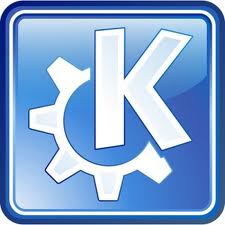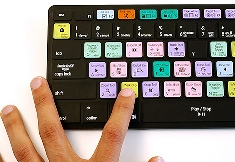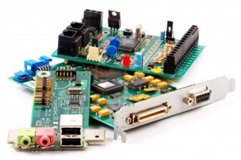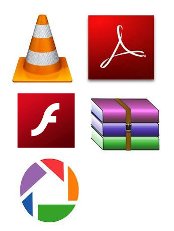

Kbps
Stands for "Kilobits Per Second." Don't confuse this with Kilobytes per second (which is 8 times more data per second). This term is commonly used in describing data transfer rates. For example, two common modem speeds are 33.6 Kbps and 56 Kbps.
KDE
Stands for "K Desktop Environment." KDE is a contemporary desktop environment for Unix systems. It is a Free Software project developed by hundreds of software programmers across the world. Both the KDE source code and the software itself are made freely available to the public.

KDE's primary benefit is the modern graphical user interface GUI it provides for Unix workstations. While Unix systems are notoriously difficult for novice users to operate, KDE makes it possible for the average user to work on a Unix system. In addition to the modern interface, KDE also includes several user-friendly features, such as an application help system and standardized menus and toolbars. It also supports the ability to customize the interface with various skins or themes.
Another important aspect of the K Desktop Environment is its application development framework, which is what software engineers use to develop programs for KDE. Since a desktop environment is only as useful as the applications available for it, it is important that developing software for the environment is not a tedious process. Therefore, the KDE application development framework has been designed to help programmers develop robust applications in a simple and efficient manner. This has lead to the development of KOffice and hundreds of high-quality programs for KDE.
Kernel
This is a term for the computing elite, so proceed at your own risk. To understand what a kernel is, you first need to know that today's operating systems are built in "layers." Each layer has different functions such as serial port access, disk access, memory management, and the user interface itself. The base layer, or the foundation of the operating system, is called the kernel. The kernel provides the most basic "low-level" services, such as the hardware-software interaction and memory management. The more efficient the kernel is, the more efficiently the operating system will run.
Keyboard
As the name implies, a keyboard is basically a board of keys. Along with the mouse, the keyboard is one of the primary input devices used with a computer. The keyboard's design comes from the original typewriter keyboards, which arranged letters and numbers in a way that prevented the type-bars from getting jammed when typing quickly. This keyboard layout is known as the QWERTY design, which gets its name from the first six letters across in the upper-left-hand corner of the keyboard.

While the design of computer keyboards may have come from typewriters, today's keyboards have many other keys as well. Modifier keys, such as Control, Alt/Option, and Command (Mac) or the Windows key (Windows) can be used in conjunction with other keys as "shortcuts" to perform certain operations. For example, pressing Command-S (Mac), or Control-S (Windows) typically saves a document or project you are working on. Most of today's computer keyboards also have a row of function keys (F1 through F16) along the top of the keyboard, arrow keys arranged in an upside-down T, and a numeric keypad on the right-hand side. Some keyboards have even more buttons, allowing you to change the system volume, eject a CD, or open programs such as your e-mail or Web browser.
Keyboard Shortcut
A keyboard shortcut is a key combination that performs a certain command, such as closing a window or saving a file. For example, pressing "Control-S" in a Windows program or "Command-S" on the Mac is the standard shortcut for saving an open document. You can also usually close a window on the Mac by pressing "Command-W" or by pressing "Alt-F4" in Windows. The shortcut for copying data is usually "Control-C" (Windows) or "Command-C" (Mac) and for pasting data, it is "Control-V" (Windows) or "Command-V" (Mac).
Most keyboard shortcuts are shortcuts for commands located in a program's menu bar. For example, most of the commands within the File and Edit menus have standard shortcuts. Each command that has a keyboard shortcut usually has the shortcut listed next to the command in the menu. For example, the Save option in a Windows program will usually have the text "Ctrl+S" next to it, indicating that pressing Control and S together will save the document.
Keylogger
A keylogger is a program that records the keystrokes on a computer. It does this by monitoring a user's input and keeping a log of all keys that are pressed. The log may saved to a file or even sent to another machine over a network or the Internet.
Keylogger programs are often deemed spyware because they usually run without the user knowing it. They can be maliciously installed by hackers to spy on what a user is typing. By examining the keylog data, it may be possible to find private information such as a username and password combination. Therefore, keyloggers can be a significant security risk if they are unknowingly installed on a computer.
The best way to protect yourself from keylogger programs is to install anti-virus or security software that warns you when any new programs are being installed. You should also make sure no unauthorized people have access to your computer. This is especially true in work environments. You can also periodically check the current processes running on your computer to make sure no keyloggers or other malware programs are active. While it is unlikely that you have a keylogger programs installed on your computer, it is definitely worth it to check.
Keystroke
A keystroke is typing one character on a keyboard (not stroking your keyboard like a cat). Every time you hit a key, you perform a keystroke. Therefore, 5400 keystrokes in one hour means hitting 5400 keys in one hour, or 90 keys a minute (5400 keystrokes ? 60 minutes).
Sometimes keystrokes per hour (KSPH) or keystrokes per minute (KSPM) are used to measure typing speed instead of words per minute (WPM). After all, typing the word "hi" 50 times doesn't take quite as long as typing "Nebuchadnezzar" 50 times.
Keywords
Keywords are words or phrases that describe content. They can be used as metadata to describe images, text documents, database records, and Web pages. A user may "tag" pictures or text files with keywords that are relevant to their content. Later on, these files may be searched using keywords, which can make finding files much easier. For example, a photographer may use a program like Extensis Portfolio or Apple iPhoto to tag his nature photos with words such as "nature," "trees," "flowers," "landscape," etc. By tagging the photos, he can later locate all the pictures of flowers by simply searching for the "flowers" keyword.
Keywords are used on the Web in two different ways: 1) as search terms for search engines, and 2) words that identify the content of the website.
1) Search Engine Search Terms
Whenever you search for something using a search engine, you type keywords that tell the search engine what to search for. For example, if you are searching for used cars, you may enter "used cars" as your keywords. The search engine will then return Web pages with content relevant to your search terms. The more specific keywords you use, the more specific (and useful) the results will be. Therefore, if you are searching for a specific used car, you may enter something like "black Honda Accord used car" to get more accurate results.
Many search engines also support boolean operators that can be used along with keywords to further refine the search. For example, you may search for "Apple AND computers NOT fruit" if you only want results related to Apple products and not the kind of apples that grow on trees.
2) Web Page Description Terms
Keywords can also describe the content of a Web page using the keyword meta tag. This tag is placed in the
Kibibyte
A kibibyte is a unit of data storage that equals 2 to the 10th power, or 1,024 bytes.
While a kilobyte can be estimated as 10^3 or 1,000 bytes, a kibibyte is exactly 1,024 bytes. This is to avoid the ambiguity associated with the size of kilobytes. A kibibyte is 1,024 bytes and precedes the mebibyte unit of measurement.
Kilobyte
A kilobyte is 2 to the 10th power, or 1,024 bytes.
"But doesn't 'kilo' means one thousand?" you ask. Well yes, but in the computer world, certain rules and guidelines don't have the same influence they do in other areas of life. Just ask any computer programmer. A kilobyte is technically 1,024 bytes because it is measured by 2^10, which equals 1,024. However, kilobytes are often estimated as 10 to the 3rd power, or 1,000 bytes. While this makes it easier to add kilobytes together, estimating can throw off larger measurements. This is because 1,024 kilobytes equal one megabyte, 1,024 megabytes equal one gigabyte, and so on.
Most small files on your computer are measured in kilobytes. For example, thumbnail images might use only 5 to 10KB of space. A larger 900x600 pixel JPEG image can take up 250KB of space. Text files are often less than 1KB. Most documents you save on your computer should be between 1 and 1,024KB. Anything larger than 1,024KB is measured in megabytes.

| Terms |
| Kbps |
| KDE |
| Kernel |
| Keyboard |
| Keyboard Shortcut |
| Keylogger |
| Keystroke |
| Keywords |
| Kibibyte |
| Kilobyte |
| Web Pages by Students |
ABC of C Language by Shailender Sharma |
Bootable Pen Drive by Avtar Singh |
e-Trash or e-Treasure? by Pallavi Bagga |
Lakshya by Rabina Bagga |
OOPs Concepts by Navjot Kaur |
Fitness First by Ankush Rathore |
Information Systems by Kajal Gupta |
Quiz Contest in C++ by Rajnish Kumar |
Core Java (Tutorial) by Shyena |
C Language Q&A by Anmol Sharma |
HTML 5 Tutorial by Kishan Verma |








